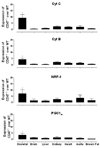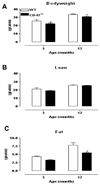Age-dependent regulation of skeletal muscle mitochondria by the thrombospondin-1 receptor CD47
- PMID: 21256215
- PMCID: PMC3070423
- DOI: 10.1016/j.matbio.2010.12.004
Age-dependent regulation of skeletal muscle mitochondria by the thrombospondin-1 receptor CD47
Abstract
CD47, a receptor for thrombospondin-1, limits two important regulatory axes: nitric oxide-cGMP signaling and cAMP signaling, both of which can promote mitochondrial biogenesis. Electron microscopy revealed increased mitochondrial densities in skeletal muscle from both CD47 null and thrombospondin-1 null mice. We further assessed the mitochondria status of CD47-null vs WT mice. Quantitative RT-PCR of RNA extracted from tissues of 3 month old mice revealed dramatically elevated expression of mRNAs encoding mitochondrial proteins and PGC-1α in both fast and slow-twitch skeletal muscle from CD47-null mice, but modest to no elevation in other tissues. These observations were confirmed by Western blotting of mitochondrial proteins. Relative amounts of electron transport enzymes and ATP/O(2) ratios of isolated mitochondria were not different between mitochondria from CD47-null and WT cells. Young CD47-null mice displayed enhanced treadmill endurance relative to WTs and CD47-null gastrocnemius had undergone fiber type switching to a slow-twitch pattern of myoglobin and myosin heavy chain expression. In 12 month old mice, both skeletal muscle mitochondrial volume density and endurance had decreased to wild type levels. Expression of myosin heavy chain isoforms and myoglobin also reverted to a fast twitch pattern in gastrocnemius. Both CD47 and TSP1 null mice are leaner than WTs, use less oxygen and produce less heat than WT mice. CD47-null cells produce substantially less reactive oxygen species than WT cells. These data indicate that loss of signaling from the TSP1-CD47 system promotes accumulation of normally functioning mitochondria in a tissue-specific and age-dependent fashion leading to enhanced physical performance, lower reactive oxygen species production and more efficient metabolism.
Copyright © 2011 Elsevier B.V. All rights reserved.
Figures






References
-
- Benton CR, Wright DC, Bonen A. PGC-1alpha-mediated regulation of gene expression and metabolism: implications for nutrition and exercise prescriptions. Applied physiology, nutrition, and metabolism = Physiologie appliquee, nutrition et metabolisme. 2008;33:843–862. - PubMed
-
- Bordone L, Cohen D, Robinson A, Motta MC, van Veen E, Czopik A, Steele AD, Crowe H, Marmor S, Luo J, et al. SIRT1 transgenic mice show phenotypes resembling calorie restriction. Aging Cell. 2007;6:759–767. - PubMed
-
- Carlezon WA, Jr, Duman RS, Nestler EJ. The many faces of CREB. Trends in neurosciences. 2005;28:436–445. - PubMed
Publication types
MeSH terms
Substances
Grants and funding
LinkOut - more resources
Full Text Sources
Other Literature Sources
Medical
Molecular Biology Databases
Research Materials
Miscellaneous

